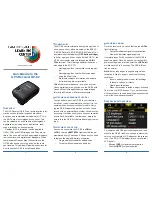
QuickGuide to the
GPS Receiver GP-E2
1
2
3
ACQUIRING A SIGNAL
Once the receiver is on, check that the red
<GPS>
light is blinking.
• Fast blink indicates signal not yet acquired
• Slow blink indicates signal acquired
It normally takes 30–60 seconds for the GP-E2 to
acquire a signal. Once it has done so it will shift to
power-saving mode, at which point the
<GPS>
light
will blink every 3 to 6 seconds. The GPS will func-
tion as normal.
Note:
It may take longer to acquire a signal and
reception is likely to be poor under the following
conditions:
• Indoors, underground, or near tall buildings
• In tunnels, valleys, or forests
• Near high-voltage lines
• When the receiver is inside a bag or suitcase
This is true of all GPS devices. Try to work outdoors,
with the receiver exposed, and with an unobstructed
view of the sky whenever possible.
GPS DEVICE SETTINGS MENU
For cameras with GPS device settings menu: In ad-
dition to the GP-E2 itself, you can see a status indi-
cator on your camera’s LCD whenever the receiver
is on. (The EOS-1D X displays this on smaller rear
LCD panel.)
• Blinking
[GPS]
= signal not yet acquired
• Constant
[GPS]
= signal acquired
OVERVIEW
The GPS Receiver GP-E2 can record location infor-
mation such as latitude, longitude, elevation,
direction, and coordinated universal time (UTC) in
the EXIF data of your images as you shoot. This
can be valuable in a wide variety of photographic
applications, including travel, architecture, land-
scape, forensics, and documentary.
Geotags (GPS information) can be applied to
RAW (.CR2) and JPEG images only. They are vis-
ible in Canon as well as third-party image browsers,
raw converters, and digital asset managers. When
combined with Canon’s Map Utility software, the
GP-E2 also allows you to log and view the route
you traveled. This guide will provide instructions for
how to use the GP-E2 to its full capabilities.
COMPATIBILITY
The GP-E2 can transfer data directly through the hot
shoe, as you shoot, when mounted on the EOS-1D
X, EOS 5D Mark III, EOS 6D, EOS M, Rebel 4Ti, or
any later model that displays
[GPS device settings]
in its Set-up menu. When used with the EOS 7D, the
GP-E2 can transfer data only through the
<DIGI-
TAL>
terminal. The following additional restrictions
also apply to the EOS 7D:
• Geotagging will not work while recording mov-
ies.
• Geotagging will not work with movies when
using the Map Utility.
• Electronic compass information and automa-
tic time setting are not available.
With all cameras listed above, as well as all other
Canon digital cameras, you can use the GP-E2 with
Canon’s Map Utility application to geotag images
later with a Windows or Macintosh computer.
ATTACHING AND REMOVING THE GP-E2
You can either mount the GP-E2 to your camera’s
hot shoe or carry it separately and connect it to the
camera with an accessory connector cable. Carry-
ing the GP-E2 separately will free up the hot shoe
for use with an external flash or other shoe-mounted
accessory. It will also allow you to use your camera’s
built-in flash, if available. In either case, always be
sure to turn the GP-E2 off before attaching or remov-
ing it.
SWITCHING THE GP-E2 ON
As soon as you switch the GP-E2 to
<ON>
or
<LOG>
, the red
<BATTERY>
light should blink ap-
proximately every 5 seconds. If it does not, you need
to replace the single AA battery; otherwise:
• Single slow blink indicates battery okay
• Three fast blinks indicates battery low


